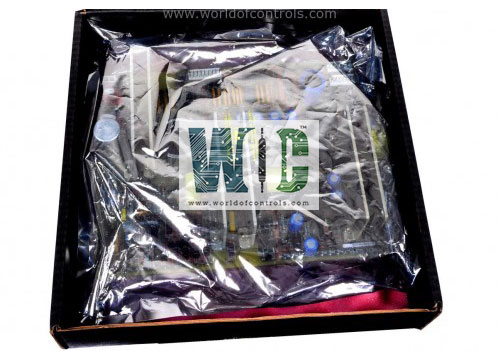
World Of Controls understands the criticality of your requirement and works towards reducing the lead time as much as possible.
IC3600AOAA1 - Operational Amplifier Control Board is available in stock which ships the same day.
IC3600AOAA1 - Operational Amplifier Control Board comes in UNUSED as well as REBUILT condition.
To avail our best deals for IC3600AOAA1 - Operational Amplifier Control Board, contact us and we will get back to you within 24 hours.
SPECIFICATIONS:
Part No: IC3600AOAA1
Manufacturer: General Electric Fanuc
Product Type: Operational Amplifier Control Board
Function: Differential signal amplification
Power Supply Dual supply: +15V / –15V
Open-Loop Gain (Ao): 100,000 – 1,000,000
Emitter Resistor (Re) Typically 100 Ohms – 1 k Ohms
Mounting / Connector: Type 25-pin edge connector
Weight 0.75 lbs
Size: 8.83 x 3.58 x 4.7 inches
Product Lifecycle: Discontinued By Manufacturer
Availability: In Stock
Country of Origin: USA
FUNCTIONAL DESCRIPTION:
IC3600AOAA1 is an Operational Amplifier Control Board manufactured and designed by General Electric as part of the Mark II Series used in GE Speedtronic Control Systems. An Operational Amplifier is a fundamental voltage-amplifying device widely used in analog electronics, designed to amplify voltage signals with the help of external feedback components such as resistors and capacitors connected between its input and output terminals. Structurally, it is a three-terminal device consisting of two high-impedance inputs and one output terminal. The inverting input (–) produces an output signal that is 180 degrees out of phase with the input, while the non-inverting input (+) produces an output signal in phase with the input.
The output terminal can both source and sink voltage or current, depending on the connected load. In linear operation, the output voltage is equal to the amplifier’s gain multiplied by the difference between the voltages at the non-inverting and inverting inputs. Based on the configuration of input and output signals, op-amps can exhibit various types of gain, including inverting, non-inverting, differential, and unity gain (voltage follower). These versatile devices are used in a wide range of applications such as signal amplification, analog computation, active filtering, voltage buffering, and precise control systems. By integrating external components, op-amps can be tailored to perform countless functions, making them a cornerstone of analog electronics and industrial control applications.
INVERTING OPERATIONAL AMPLIFIER:
The circuit operates from a dual power supply, +Vcc and –Vee, which ensures a stable and consistent voltage for proper operation. The output voltage (Vout) of the amplifier represents the difference between the two input signals, as the inputs are configured in anti-phase with each other. When the forward bias of transistor TR1 increases, the forward bias of transistor TR2 correspondingly decreases, and vice versa. If the two transistors are perfectly matched, the current through the common emitter resistor (Re) remains constant, resulting in a balanced output signal. Since the collector voltages of the transistors swing either in opposite directions (anti-phase) or together (in-phase), the output voltage, measured between the two collectors, ideally remains at zero difference in a perfectly balanced circuit.
OPERATIONAL AMPLIFIER:
Operational amplifiers typically have a single low-impedance output referenced to a common ground, although some designs feature an additional differential output. Ideally, the amplifier should ignore common-mode signals, meaning that if identical voltages are applied to both the inverting and non-inverting inputs, there should be no change in the output. In practice, however, real amplifiers exhibit some variation, and the ratio of the output change to the change in common-mode input voltage is known as the Common Mode Rejection Ratio (CMRR). A high CMRR indicates that the amplifier effectively rejects unwanted common-mode signals, which is crucial for precision applications.
Operational amplifiers typically operate from a dual power supply (+Vcc and –Vee), ensuring stable operation. The output voltage reflects the difference between the two input signals, as the inputs are usually in anti-phase. In a differential amplifier configuration, when one transistor’s forward bias increases, the other decreases, maintaining a constant current through the common emitter resistor and producing a balanced output. Collector voltages swing either in opposite directions (anti-phase) or together (in-phase), and in a perfectly balanced circuit, the output voltage measured between the collectors ideally remains zero. Op-amps generally have a single low-impedance output referenced to a common ground and are designed to ignore common-mode signals, meaning identical voltages applied to both inputs produce no output change. In real devices, slight variations occur, and the Common Mode Rejection Ratio (CMRR) quantifies the amplifier’s ability to reject these common-mode signals.
WOC maintains the largest inventory of OEM replacement parts for GE Speedtronic Turbine Control Systems, ensuring that your operations remain uninterrupted. In addition to supplying new and unused parts, we also offer expertly rebuilt and refurbished boards, each backed by a comprehensive warranty for your peace of mind. Our highly trained team of automation specialists is available 24/7 to provide technical support, assist with troubleshooting, and help you identify the exact parts or solutions you need for your turbine control systems. Whether you require emergency repairs, routine maintenance, or assistance with system upgrades, WOC is committed to delivering reliable, high-quality service tailored to your operational requirements. For pricing, availability, or consultation on parts and repair services, please contact our team directly by phone or email. We will provide prompt and professional support.
What is Common Mode Rejection Ratio (CMRR)?
CMRR is the ratio that indicates the amplifier’s ability to reject signals common to both inputs, such as noise. A high CMRR ensures the output responds primarily to the differential input voltage rather than unwanted interference.
What power supply does the board require?
Most operational amplifier control boards, including the IC3600AOAA1, operate from a dual supply, typically +15V and -15V, to ensure stable linear operation.
Can the output be differential or single-ended?
The standard output is single-ended with low impedance, referenced to a common ground. Some designs may also provide a differential output for specific control system applications.
Why choose this operational amplifier board?
It offers high differential gain, excellent common-mode rejection (CMRR), and reliable performance for industrial turbine and automation systems.